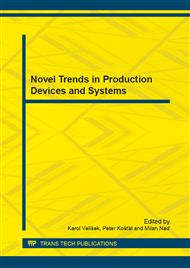[1]
L. Kukielka, K. Kukielka, A. Kulakowska, R. Patyk, L. Malag, L. Bohdal, Incremental Modelling and Numerical Solution of the Contact Problem Between Movable Elastic and Elastic/Visco-Plastic Bodies and Application in the Technological Processes (in this Journal).
DOI: 10.4028/www.scientific.net/amm.474.159
Google Scholar
[2]
J. Kulik J, H. Olszak-Kulik, Study the technological properties of metals (in Polish), Publisher Koszalin University of Technology, Koszalin, (2003).
Google Scholar
[3]
Z. Marciniak, Design of press tools (in Polish), Technical Center A. Marciniak, Warsaw, (2002).
Google Scholar
[4]
L. Malag, L. Kukielka, K. Kukielka, A. Kulakowska, L. Bohdal, R. Patyk, Problems Determining of the Mechanical Properties of Metallic Materials from the Tensile Test in the Aspect of Numerical Calculations of the Technological Processes (in this Journal).
DOI: 10.4028/www.scientific.net/amm.474.454
Google Scholar
[5]
P. Kaldunski, Modelling and simulation forming of circularly-symmetrical drawpieces without flange with the regard of the geometrical and physical nonlinearity (in Polish), PhD thesis, Koszalin, (2009).
Google Scholar
[6]
F. Barlat, D. J. Lege, J. C. Brem, A Six-Component Yield Function for Anisotropic Materials, International Journal of Plasticity 7 (1991) 693-712.
DOI: 10.1016/0749-6419(91)90052-z
Google Scholar
[7]
Ansys Ls/Dyna User's Guide.
Google Scholar
[8]
R. Patyk, L. Kukielka, Optimization of geometrical parameters of regular triangular asperities of surface put to smooth burnishing, Steel Research International, in Special Eds., Metal Forming, Publishing Company Wiley-VCH Verlag (2008) 642-647.
Google Scholar
[9]
Ł. Bohdal, P. Walczak, Eco-modeling of metal sheet cutting with disc shears, Annual Set The Environment Protection 15 (2013) 863-872.
Google Scholar
[10]
A. Kulakowska, L. Kukielka, Numerical analysis and experimental researches of burnishing rolling process with taking into account deviations in the surface asperities outline after previous treatment, Steel Research International, in Special Eds., Metal Forming, Publishing Company Wiley-VCH Verlag (2008).
DOI: 10.1002/pamm.200810733
Google Scholar
[11]
A. Kulakowska, Problems of surface preparation under burnishing rolling in aspect of product quality, Steel Research International, in Special Eds., Metal Forming, Publishing Company Wiley-VCH Verlag (2010) 218-221.
Google Scholar
[12]
R. Patyk, Theoretical and experimental basis of regular asperities about triangular outline embossing technology, Steel Research International, in Special Eds., Metal Forming, Publishing Company Wiley-VCH Verlag (2010) 190-193.
Google Scholar
[13]
A. Kulakowska, Experimental researches of burnishing rolling process of regular surface asperities prepared in turning process, Steel Research International, in Special Eds., Metal Forming, Publishing Company Wiley-VCH Verlag (2012) 1419-1422.
Google Scholar


